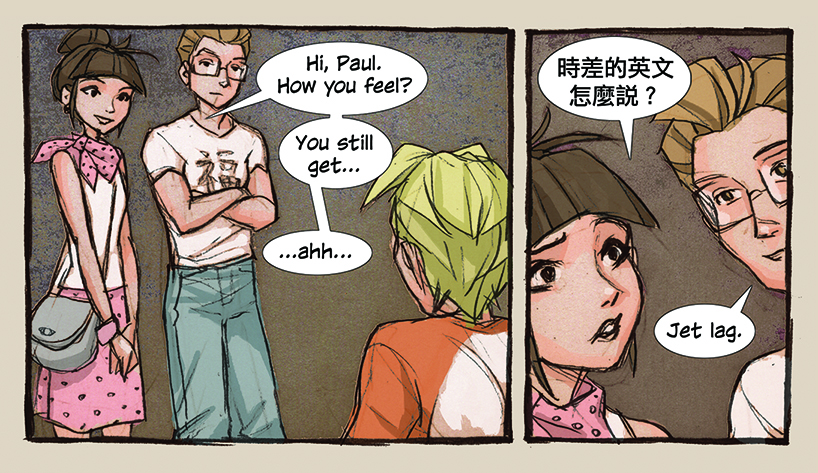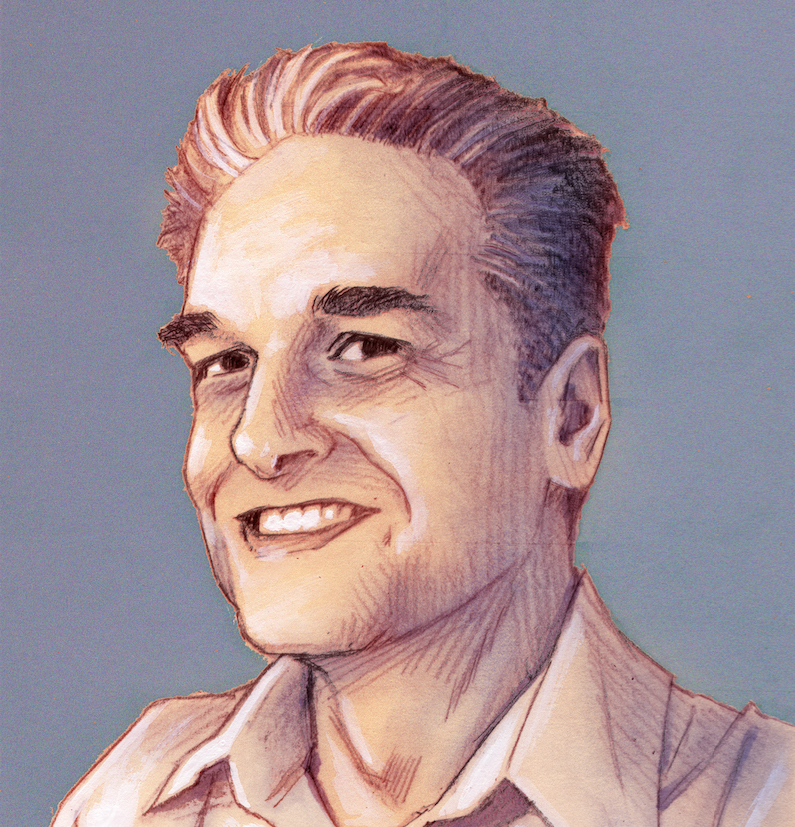LOST IN TAIWAN: The Story Behind My New Graphic Novel, a guest post by Mark Crilley

I’ll never forget the first five words I was taught to say in Chinese: “Wo shi mei guo ren.” The first two mean “I am,” and the final three mean “American.” I was nearing graduation from college at the time, and a fellow student, Ann Light, kindly agreed to give me a few lessons in Mandarin. I was due to head off to Taiwan to teach English for at least a year, and these would be the only Chinese lessons I would ever get.
I should add that she didn’t just teach me how to say those words. She taught me how to write them. And let me tell you: There’s nothing quite like the first time you learn to write in Chinese. It’s as if someone has handed you the key to a secret door. For a Westerner, there is certainly no written language that appears quite so mind-bogglingly unreadable as Chinese. But here I was, a 21 year old who’d never gone anywhere within five thousand miles of the Far East, suddenly able to read and write five Chinese characters. It was magical.
ADVERTISEMENT
ADVERTISEMENT

Flash forward more than thirty years, and I found myself with quite a different opportunity: the chance to write and illustrate a graphic novel that would pay tribute to Taiwan, and to all the experiences I had when I lived there. I knew at once that I wanted to craft a story that would allow readers to experience some of that same magic that I did. I wanted to plunk them down in the middle of Taiwan, and give them a guided tour of the place.
Now, the obvious approach was to write something straightforwardly autobiographical. But my time in Taiwan was not the stuff of drama. That story’s plot would go something like, “Guy goes overseas and has a really great time. The End.” Also, how do you distill two and a half years of life experience into a single book? I needed a story idea that would capture my love of Taiwan without being bound by the strictures of autobiography.

So it was that I came up with Paul: a high school student who is in Taiwan against his will, and—unlike me—not particularly interested in seeing the sights, or even getting up off the couch. I figured he could be a bit like Ebenezer Scrooge in this way: someone who’s got plenty of space to grow and change over the course of the story.
As for the issue of condensing years of experiences into a book-length tale, I opted to go in the completely opposite direction. What if the entire story took place over the course of a single day? That idea excited me. I’d never tried anything like it before. By limiting most of the time frame to one day, I could immerse the readers in Paul’s experience and have them feel that they were going through that same day themselves, from sun up to sundown and beyond.
I shouldn’t say too much about the plot that I cooked up, lest I spoil your enjoyment of reading the story and discovering it for yourself. But let’s just say that the title “Lost in Taiwan” is not some sort of grand metaphor. It describes what happens to Paul, quite literally.
And yes, I definitely made space in the story for the written language and my fascination with it. Early on I decided that any time a person in the story speaks Chinese, I would present their dialogue faithfully in Chinese text– right there inside the speech bubbles, with no subtitles or any other form of English translation. The idea was to make those lines of dialogue just as incomprehensible to readers as the spoken language would be to Paul (and as it was to me, during my first days in Taiwan, before I began to gain a bit of fluency).

In that sense this is the first book I’ve done that provides a radically different experience for two groups of readers. For those who can read Chinese, those panels function as a simple continuation of the dialogue. For everyone else—the vast majority of readers in America, surely—those panels put you very firmly in Paul’s shoes: locked out of the conversation, and needing to look at facial expressions and so forth to venture a guess at what’s being said.

But I didn’t leave Paul completely shut out when it came to Chinese. I included scenes in which he learns to say a few things out loud. More significantly, I devoted an extended scene to making Paul—and the readers– grapple a bit with the written language (courtesy of a can of Coca-Cola, believe it or not). Anyone who reads “Lost in Taiwan” has the opportunity to learn at least one Chinese character: what it looks like and what it means. If I’ve done my job right, you will feel, as Ann Light made me feel, that someone has handed you the key to a secret door.
And whether you open that door eagerly the way I did, or get shoved through it accidentally like Paul, one thing’s for sure: there’s life-changing stuff on the other side.
Meet the author

Mark Crilley is the author and illustrator of more than forty books, including several acclaimed graphic novels, for which he has received fourteen Eisner Award nominations. His work has been featured in USA Today, Entertainment Weekly, and on CNN Headline News. His popular YouTube videos have been viewed more than 400 million times. He lives in Michigan with his wife, Miki, and children, Matthew and Mio.
Social media links:
TWITTER: http://www.twitter.com/markcrilley
INSTAGRAM: http://instagram.com/markcrilleyreal/
FACEBOOK: http://www.facebook.com/markcrilleyOFFICIAL
YOUTUBE: http://www.youtube.com/markcrilley
About Lost in Taiwan
ADVERTISEMENT
ADVERTISEMENT
In this exciting graphic novel about stepping out of your comfort zone, a traveler finds himself lost in Taiwan with no way of finding his brother—but he soon learns that this forced disconnect is helping him explore and experience the big wide world around him.
THIS WASN’T PAUL’S IDEA.
The last thing he’s interested in is exploring new countries or experiencing anything that might be described as “cultural enrichment.” But like it or not, he’s stuck with his brother, Theo, for two weeks in Taiwan, a place that—while fascinating to Theo—holds no interest to Paul at all.
While on a short trip to a local electronics store, Paul becomes hopelessly lost in Taiwan’s twisting, narrow streets, and he has no choice but to explore this new environment in his quest to find his way back to Theo’s apartment.
In an unfamiliar place with no friends—and no GPS!—there’s no telling what adventures he could happen upon. And who knows? Maybe it turns out he has friends in Taiwan, after all.
ISBN-13: 9781368040990
Publisher: Little, Brown Books for Young Readers
Publication date: 05/23/2023
Age Range: 12 – 18 Years
Filed under: Guest Post
About Amanda MacGregor
Amanda MacGregor works in an elementary library, loves dogs, and can be found on Twitter @CiteSomething.
ADVERTISEMENT
ADVERTISEMENT
SLJ Blog Network
Name That LEGO Book Cover! (#53)
Cover Reveal and Q&A: The One and Only Googoosh with Azadeh Westergaard
Exclusive: Vol. 2 of The Weirn Books Is Coming in October | News
Fighting Public School Book Bans with the Civil Rights Act
ADVERTISEMENT







